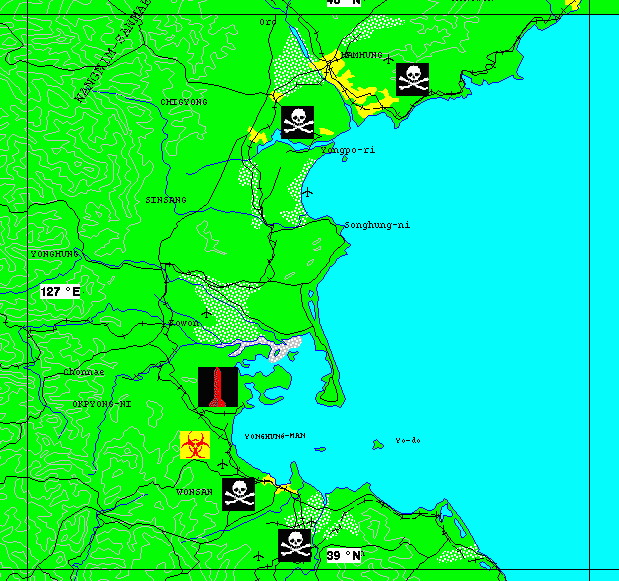

Kim Jong-il has a secret affection on the US. He loves Hollywood movies, he has insisted on bilateral negotiation with Americans alone, now he is goes one step furtehr in congratulating the 230th anniversary of the Great American Revolution with a series of fireworks.
-
(update - Bloomberg) 3:33 a.m. Scud-C, short-range ballistic missile, is launched. It lands in the Sea of Japan, short of Japanese coastline.
4:04 a.m. Rodong, medium-range ballistic missile, or a Scud-C is fired and lands short of Japan. This and first launch were not considered unusual by U.S. officials.
5:01 a.m. Taepodong-2, long-range ballistic missile, is launched and vanishes in less than a minute. This missile also landed in the Sea of Japan.
7:12 a.m. Scud-C, or other missile, fired and lands in Sea of Japan at 7:17 a.m.
7:31 a.m. Rodong missile is launched, landing in the Sea of Japan at 6:36 a.m. - (Update - AustraliaBC interview of Hugh White, ANU)
- KERRY O'BRIEN: Of course this is an enormously sensitive issue for the region, the whole question about Japan re-arming, so to speak, and that's a debate that's been gaining increasing currency in Japan anyway, hasn't it?
- PROFESSOR HUGH WHITE: ...The Chinese I think will be very angry with the North Koreans for, amongst other reasons, the fact that these launches will help to accelerate the development of Japan's own military capabilities and that of course will affect not just the balance of power between Japan and North Korea, but the balance of power between Japan and China. So it complicates a lot of strategic calculations in North-East Asia...... I think we can expect the Chinese to respond pretty strongly to this.
- KERRY O'BRIEN: That brings us to the final question: why on earth are they doing it? What's behind North Korea?
- PROFESSOR HUGH WHITE: It's a very hard question to answer, Kerry. There are two parts to it at least. The first is that I've no doubt that the North Koreans genuinely want to develop their capabilities and genuinely want to test missiles like the Taepodong-2 because they want to move towards the capacity to put a nuclear weapon on the United States, but I think there's also an element of diplomacy in this. In particular, they are in the middle of the six-party talks. The talks have been stalled for nearly a year now and the North Koreans are looking to get the US in particular to put more on the table, as an incentive for the North Koreans to walk away from their nuclear program and this is one way of upping the stakes and making the Americans more likely to put more on the table and give the North Koreans a better deal. It's a pretty high stakes way of conducting a negotiation, but that's the way that the North Koreans do it.
It is still unclear how many were fired, though it was believed to be 5, 6, 7 (and counting). Reportedly many were short-range Scud and the medium range Taepodong-2 failed (updates)
- 1) Sea of Japan does not mean it is part of Japan, just like Persian Gulf does not wholly belong to Iran, and Indian Ocean not wholly part of India. It could be misleading for those who are not familiar with geography.
- In fact, Japan's sovereign territory is only 12 nautical miles (22km) from its coast line. Its claimed EEZ can extend to 200 nautical miles (as long as it does not overlap the 200 n-mile zone or the continental shelf of another country) but this is disputed mainly because of the Dokto(Liancourt) dispute. (That Korean insisted that this be called "East Sea" seems to make sense now). So, in reality the Sea of Japan is international water, and the EEZ is shared by Korea, Russia and Japan.
- 2) Japan's claimed EEZ is shown as the yellow line in the map above. Note that Korea's claimed EEZ is to the East of this line because one would have to take Dokto/Liancourt and find the mid-line with Honshu.
- 3) The west end of the red line is 600km west of Hokkaido, where the missile reportedly fell. It is about 100km south of Vladivostok in international water, and probably falls in the EEZ of Russia.
- 4) All the 6 missiles (including the successfully launched Scud/Ronong) fell onto international waters


However, it was said that there may be more than one such launch sites for the 3-5 missiles fired. A couple hundred km south is the nuke siteat Soho-ri, Sinpo, near Songjin (40.09505600E,128.34080800N).

Update:
According to a South Korean spokeman, the missiles were launched from separate sites:
"This morning at 5 o’clock in Taepodong(大浦洞), Hwadae-gun (花台郡), in North Hamgyeong Province (咸镜北道) and from 3:32 a.m. in Gitdaeryung(旗杆岭), Anbyun, Gangwon Province, six missiles were launched including five Scud and Rodong and one Taepodong-2 missile," Cheong Wa Dae security secretary Suh Choo-suk said earlier reading a government statement after an emergency meeting of the National Security Council.Taepodong is the musudan-ri site above. Anbyon (安边) is SE of Wonsan (元山-江原道) in this map

2 comments:
It seems there are 7 missiles now.
China's ambassador to UN said, what NK did was "regretable", 遗憾, in Japanese it means "zannian desu" (残念).
But why was it Japan, not Korea that called the UNSC meeting? Had it been S Korea, it would get much stronger support from China.
Perhaps South Korea does not want this turned into another false WMD Iraq thing?
Does NK, or US, have the sovereign rights to missiles?
Post a Comment